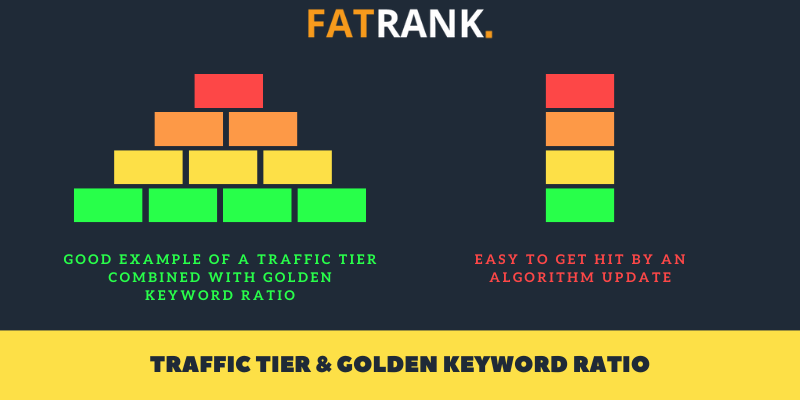
SEO Avalanche Technique
I used to hate the idea of the SEO Avalanche Technique, where Google placed websites into different tiers depending on their average monthly traffic.
I disagreed with this content SEO strategy because some high-traffic searches were very easy to rank for, and keyword difficulty was not solely based on search volume.
Now that Chris Carter has updated his SEO Avalanche Technique (who coined the phrase) to integrate Doug Cunnington’s KGR (Keyword Golden Ratio) technique, I love it.
Combining Chris Carter’s SEO Avalanche Technique with Doug Cunnington’s Keyword Golden Ratio removes the guesswork from SEO (GuesSEO).
Our SEO Avalanche Technique guide explains why using this technique with the Keyword Golden Ratio equation is necessary for building long-term rankings in Google.
Contents
What Is the SEO Avalanche Strategy?
The SEO Avalanche Strategy is the idea of traffic tiers where you should only create content you have chances to rank for in Google.
It’s a simple strategy where you start building articles with the lowest competition and it is a great way to start getting traffic to your website.
Chris Carter created the phrase ‘SEO Avalanche Technique’ where you start with the easiest keywords before moving up to higher volume and higher competition topics.
To ensure you do not gain a ‘power boost’ and then drop in rankings later on, you must stay at your ‘level’ or ‘tier’ before trying to rank for harder keywords in higher ‘levels’.
Traffic Tiers
Traffic Tiers are a term used by Chris Carter. Carter created the below table as an example of the tiers and levels he suggests:
| Tier | Traffic (daily/month) |
|---|---|
| Level 0 | 0-10 |
| Level 10 | 10-20 |
| Level 20 | 20-50 |
| Level 50 | 50-100 |
| Level 100 | 100-200 |
| Level 200 | 200-500 |
| Level 500 | 500-1000 |
| Level 1,000 | 1000-1500 |
| Level 1,500 | 1500-2000 |
| Level 2,000 | 2000-3000 |
| Level 3.000 | 3000-4000 |
| Level 4,000 | 4000-5000 |
| Level 5,000 | 5000-7500 |
| Level 7,500 | 7500-10,000 |
| Level 10,000 | 10,000-12,500 |
| Level 12,500 | 12,500-15,000 |
| Level 15,000 | 15,000-25,000 |
| Level 25,000 | 25,000 – 50,000 |
The tiers refer to levels that Google would expect your website to be in. Carter explains a website must master the level it is in before jumping to the next tier (or skipping tiers).
Therefore, as an SEO you should be looking at lower level keywords before you aim to rank the big keywords. You will then gain more topical authority allowing you to be seen by Google as a knowledgeable source.
What is a Power Boost?
A power boost is when Google gives your site extra ‘juice’, and you see a dramatic rise in rankings.
It is important to note that ‘power juice’ can be taken away, so you should not rely on this boost of power.
Various factors can cause the power boost, which may consist of the following:
- Domain age
- Domain authority
- Backlink power
- Social signals
- Pagespeed score
- On page SEO
- Google Pagerank
- Google trust factor
- Google quality rater
If Google drops your site or finds fault, you can lose this ‘juice’. What you are dropped back down to is known as your non-boost power.
By staying on each level and mastering that tier before moving to the next one, you can minimise your chances of dropping in rankings for all of your keywords if Google drops you for one particular keyword you received a power boost for.
This is known as the SEO avalanche technique.
How to Apply the SEO Avalanche Technique
To begin, you will need to find out where you are in the tiered system. You can then work your way up from there.
Firstly, check your daily Google organic traffic (get an average from the lowest and highest volume days).
When you have your average daily traffic, you will need to find a keyword that meets this traffic. For example, if your website only gets 50 visitors a day and you are targeting a keyword that gets 10,000 visitors a day, you are unlikely to rank for the term.
So, to remain in your tier, if you receive 50 visitors a day, you will need to aim for a keyword that gets 50 visitors a month.
You may think you should go after a keyword of 1,500 per month (50 per day x 30 days), however Google would not allow your website to gain this many extra visitors in a single month from one new blog article – you simply won’t have enough power to rank it.
How to Find Your Tier
To find the tier you belong in, you will need to simply publish an article and see if you rank in the top 10 for your main keyword organically.
Start with a keyword that gets 100 monthly searches. If you land in the top 10, that is your tier. If you can’t get to the top 10, you must try an easier keyword (20-50 visitors per month).
If you still have no luck, you will need to try 0-10. In the event you cannot rank a search term receiving 0-10 visitors a month, you will need to check your site for problems.
Tip: When you upload your new articles, make sure to interlink them with your money pages so they naturally rise when you build more pages.
Build Your Content Pyramid
Once you have established your tier, you can then start to create articles in your tier and get them ranking.
Start in the lowest tier (suitable for your website) and work your way up.
Make sure you don’t skip tiers! This may cause a power boost (especially if you are getting backlinks to the page), but this power can be taken away easily along with power from other pages.
We recommend using the Golden Keyword Ratio in order to build your content pyramid.
What is the Golden Keyword Ratio?
The Keyword Golden Ratio (KGR) is a Data-Driven strategy for finding long-tail keywords that are low competition in Google SERPs.
Doug Cunnington’s ratio is the number of Google results that contain the keyword in the title divided by the monthly local search volume when the search volume is below 250.
Keyword Golden Ratio is the next step on how to use the SEO avalanche method. This will help you find keywords in your tier.
Here is a video explaining the KGR technique.
If you find a phrase that meets the keyword Golden Ratio requirements and publish an article targeting that specific keyword, the rule states you should be able to rank in the top 10 within just a few days.
Some higher authority sites may even rank in the top 5!
How to Use Keyword Golden Ratio
Using the Keyword Golden Ratio (KGR) couldn’t be easier – all you need to do is follow these simple steps.
Use the Allintitle Search Parameter
‘Allintitle’ is a search parameter (or search operator) used to narrow down a particular search.
As you might already have guessed, by using ‘allintitle’, you are searching for websites with the exact combination of keywords in the meta title of their article.
It’s important to note the keywords do not necessarily have to be in the order you have searched them.
For example, if you are looking to do a blog post on ‘types of double glazing’, you would want to search ‘allintitle: types double glazing’.
You would not include ‘of’ in your search string, as some articles may not have this term; they may choose to title the article ‘double glazing types’. This will ensure you receive the most accurate results when you carry out the KGR equation.

Once you have used the allintitle search parameter for your chosen keyword, you will need to make a note of the number of search results.
Above, you can see that 77 results came back for this particular search.
Find the Search Volume
Now that you have the number of search results you will compete against; you will need to find the search volume. To do this, you can use a range of tools, including:
- Ahrefs
- Semrush
- Keyword Surfer
- Keywords Everywhere
When you have found the value of your local monthly searches, you will also need to note this.
In our case, the monthly search volume is 150.

Tip: If you are looking for other keywords to write posts on, you can use the ‘keyword suggestions’ part of Ahrefs and filter the volume to be under 250. You can then run them through the Keyword Golden Ratio equation!
Using the Keyword Golden Ratio Formula
Now that you have both of these numbers, you need to use the equation.
The Keyword Golden Ratio Formula is:
KGR = Number of allintitle results ÷ search volume
Therefore, in this case, the equation would be:
KGR = 77 ÷ 150
So, the KGR would be 0.51333…
Any KGR less than 1 is worth creating a blog post on if the search volume is less than 250. So, if you have a site on double glazing – this one is worth writing!
You should aim to get your KGR under 0.25.
By doing this, you should rank in the top 100 when Google indexes your page. If your KGR is between 0.25 and 1 (like mine is above), you should rank in the top 250 quite quickly, but you might not see results as soon as a KGR below 0.25.
We do not recommend creating posts if your KGR is above 1 (not until you have built up your platform), as the search term will be quite competitive and, therefore, difficult to rank for, especially if you are a newer site.
Tip: Before publishing your article, put the article and your domain through SERP tracker. By doing this, you will find out where your article lands on Google as soon as it is found which will help you find your tier.
Summary
Some of the best SEOs are combining the power of the SEO Avalanche Technique traffic tiers with the KGR technique to build content for new websites strategically.
The basics of this strategy are:
- Find your tier
- Use KGR to find search terms to write articles on
- Rank your articles until you reach the higher tiers.
By doing the SEO avalanche method, you will find lots more traffic coming to your website.
Think of it this way:
Popular Questions
Why You Should Target Zero Search Volume Keywords?
Zero search volume keywords are hyper-focused long tail queries for which tools cannot provide data on search history.
The ZSV keywords can show up as accidental keywords in Google Search Console or if you use amazing tools like SEO Testing.
The zero search volume keywords can drive mass amounts of traffic if the topic is trending and are usually easy to rank for keywords to help your domain build up topical authority.

About FatRank
Our aim to explain and educate from a basic level to an advanced on SEO and Social Media Marketing.
